PROVINCETOWN — Realizing there might be a limit to what can be done and learned in this world, I have taken to asking, when getting to know someone, “What are you not interested in?” The responses, I find, reveal a silhouette of each person’s world. My own answer for now — one that’s apparently controversial — is “birds, cars, and plant identification.”
My indifference to flora — its nomenclature, not its beauty — went unchallenged for years until a recent encounter with the West End lilies.
Of course, I couldn’t just call them that. What I knew was that white and pink blossoms unfurled magisterially from ribbony mantis-green leaves in the garden at 72 Commercial St., while peachy blossom orbs, dahlias, I now know, popped their heads out farther back; baby pink foxgloves, a name I learned through frantic texts to my flower-enthused mother, hung like petaled bells from sturdy stems.
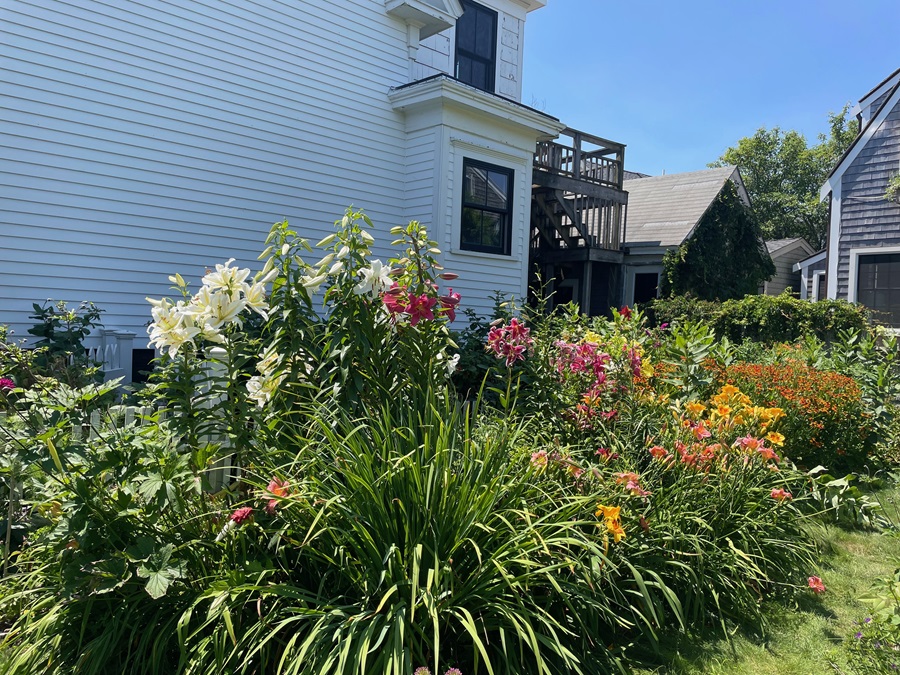
I had my change of heart as I traversed the quiet streets and home gardens past the spot where Commercial Street curls toward the harbor. I was in the more or less quiet company of close to 1,000 people. Commercial Street’s far West End was the starting spot on the Provincetown Art Association and Museum’s 25th annual Secret Garden Tour on Sunday, July 21.
The nearly 1,000 garden gazers this year were about 200 more than on last year’s tour. The $40 ticket helps pay for PAAM’s exhibitions and educational programming.
The fact that the route, which included 11 gardens along a walk that wound up Atwood Avenue and Point Street before returning to Commercial Street, was made available on maps only on the day of the event gave the tour the frisson of a scavenger hunt.

Andrew Dillman has been taking care of the garden at 72 Commercial St. for 25 years, and not much has changed in that time, he says — except for the fact that there are no bitter melons this year. And maybe that “things gravitate to where they want to be, particularly the raspberries.”
Dillman has taken a methodical approach to fending off the hungry rabbits, whose presence he attributes to a steep decline in the fox population. The bunnies have penchants for rudbeckia and spindly amaranth, steering clear of calendula and basil, he has noticed. A maze of plastic tines in the ground has helped ward them off, too: “They don’t like to be poked,” Dillman says.
At each backyard garden, many of which take hours of weeding and pruning per day to reach their polychromatic potentials, there’s a feeling of entering a secret world.
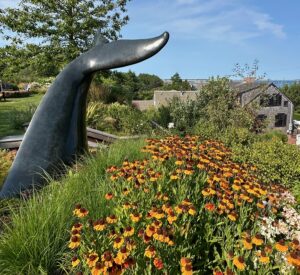
Getting to see places you would not normally see is part of the allure of the tour, says Angela C. Brown, a PAAM volunteer who’s helping to guide. Beyond just seeing the gardens, she adds, “You see how lovingly these people have taken care of putting them together.”
Michael Abdella and Nick Olivieri live at 50 Point St., where Abdella spends hours every day on his hands and knees. His eyes half close as he describes the feeling of peace in which gardening enshrouds him: he meditates, he feels safe, he prays to his father, “who taught me everything I know,” he says.
Down a sloping drive, gardener Anthony Arakelian sits chameleon-like on a bench in a meditation garden he’s spent 22 years cultivating. “I love my job, honey,” he says. He works with stones, positioning their jagged edges so that they “flow more like water.” The paths cascade and meander among candles and shady tree cover and “the majesty of what God created and not man.”
The biggest sunflower I have ever seen resides on Atwood Avenue. Fleshy and humanoid in its tilt, as if bowing, it stands not far from a pot of baby eggplants, which dangle thumblike behind sprawling leaves.
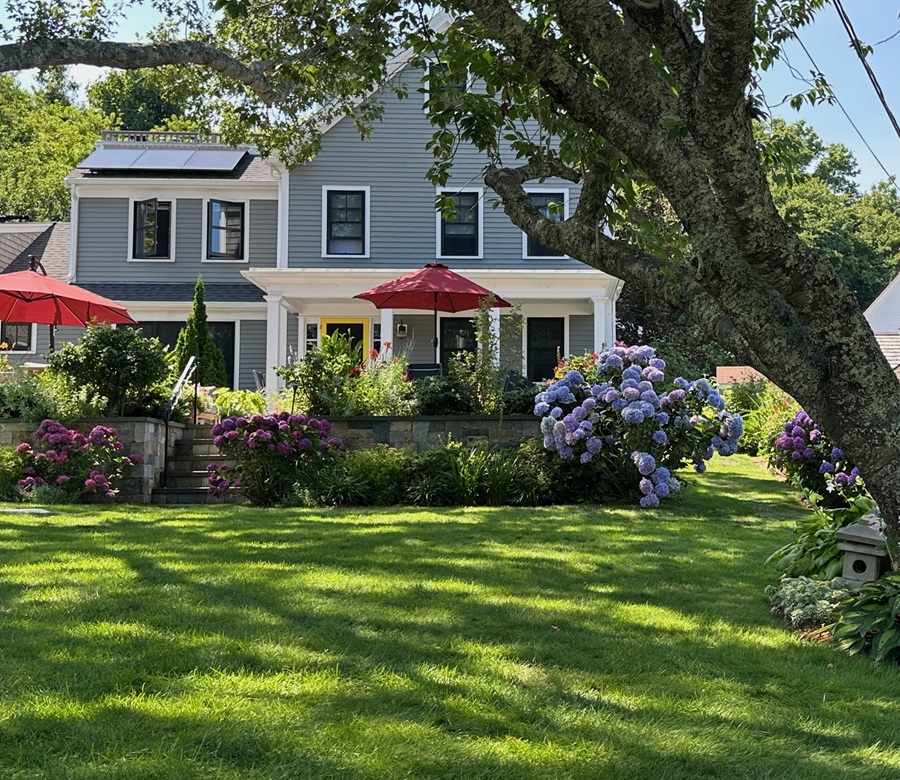
One garden-proud East Ender declares that while these West End gardens are pretty, they don’t measure up to last year’s tour on the other end of town, which, incidentally, included his house. There, he alleges, the gardens sprawl farther out, overlooking the water. I follow him across town to learn about Persian tobacco and the advantages of gardening on the East End.
According to PAAM’s chief operating officer, Grace Ryder-O’Malley, homeowners reach out to PAAM now and then offering up their gardens for the tour. “I do think there’s a lot of pride that comes in being able to be part of it,” she says. But the foot traffic and the scrutiny can be intense, so some prefer to keep their gardens off the circuit.
“It’s kind of piecemeal getting all the gardens selected,” says Ryder-O’Malley. PAAM likes to go for range — including tomatoes and wild blackberries — and not just “very manicured, traditional” gardens.
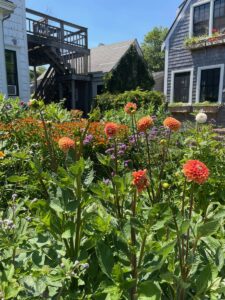
Hydrangeas hog the spotlight in many a yard this year, and for good reason: the bursts of fuchsia, lavender, periwinkle, and maroon thrive after a rain-heavy spring. We are living in a period of “hydrangea hysteria,” C.L. Fornari, the founder of the Cape Cod Hydrangea Festival, told the New York Times in July.
Up the stone steps at Land’s End Inn, where garden tourists get a view of the breakwater and bay, petunias and begonias erupt from tiered pots. The scene is enchanted Provincetown, right out of a fairy tale.
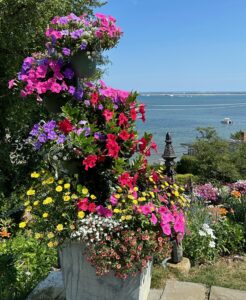
Laz Hernandez and David Hay are PAAM volunteers stationed at the Red Inn, the second-to-last stop on the tour. By now, the day is steamy and the tour is winding down; conversation has shifted to the newly announced presumptive Democratic Party nominee.
Hay, an Eastham-dwelling orchid enthusiast, is delighted by people’s gardens and by their delight in sharing them. Hernandez, who lives at Seashore Point — where there’s a gardening club, he says, though he’s not a member — is here for the community and the T-shirts.
“I’m a city boy,” says Hernandez, who’s from New York, which reminds me of my New Jersey roots and the brand-newness of my collection of plants’ names. “When you’re a city boy, it’s all just green and color.”



